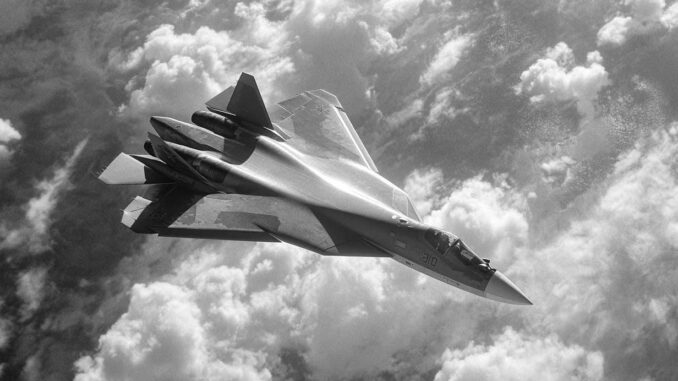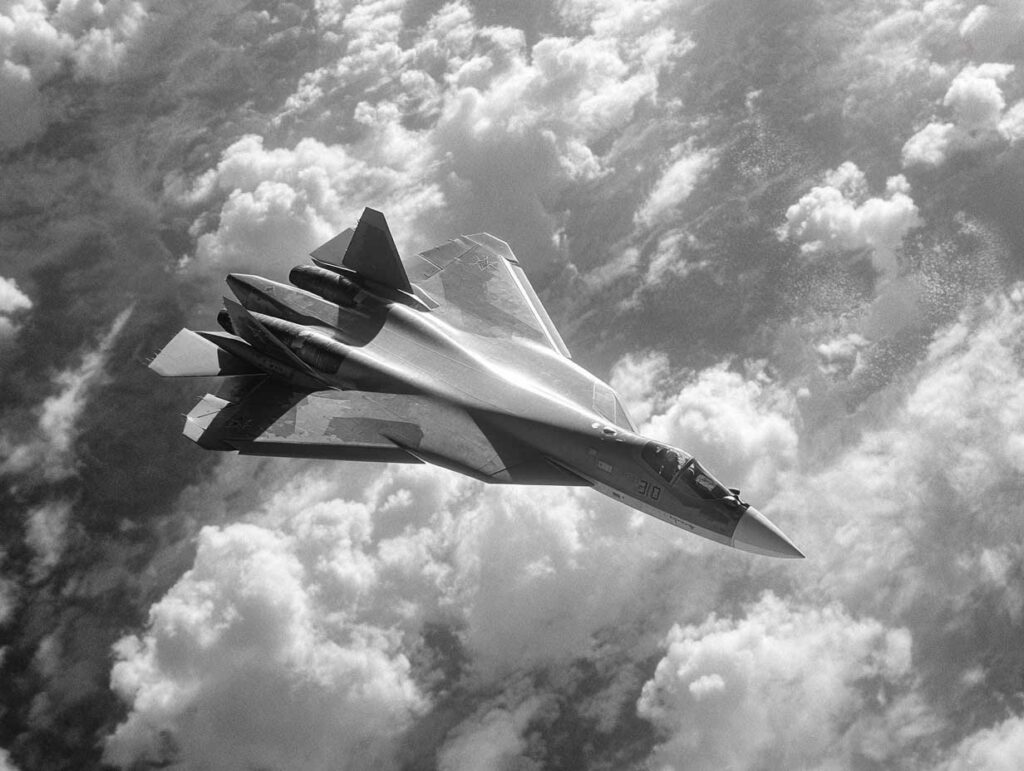
Russia is stepping up use of its Su-57 in Ukraine to test weapons and tactics and gain credibility with its few foreign customers.
Intensified operational use of the Su-57
For several months now, the Su-57 Felon, the Russian army’s fifth-generation fighter jet, has been increasingly involved in the conflict in Ukraine. According to several sources close to Ukrainian military circles, the aircraft are being used in formation, sometimes in pairs or trios, with specific roles for each unit. This development marks a clear break with the cautious use seen at the start of the war in 2022, when the Su-57 was only occasionally deployed and mainly held back.
The objective seems clear: to gain real combat experience, refine engagement doctrines, and validate the aircraft’s theoretical capabilities. The presence of the Su-57 in the Ukrainian theater is therefore a tactical laboratory in a modern war context saturated with Western air defenses.
A rare aircraft but used more aggressively
Despite still very limited production—fewer than 20 units delivered to date, according to cross-referenced data—the Su-57 is beginning to appear more frequently in operations in Ukraine. Reports mention complete formations, in which the aircraft divide up tasks: one neutralizes long-range air threats with R-77M missiles, while others carry out ground strikes with Kh-69 cruise missiles or guided bombs.
This structured approach shows that Russian pilots are undergoing specific tactical training and that Su-57 deployment doctrines are evolving rapidly. Added to this is the testing of new weapons, including a possible hybrid missile or drone nicknamed “Su-71K,” which would combine radar stealth and high maneuverability.
An attempt to adapt to Ukrainian defenses
The more assertive deployment of the Su-57 cannot be explained solely by internal Russian considerations. It is also a direct response to the growing effectiveness of Ukrainian air defenses, which have been greatly strengthened by Western deliveries (IRIS-T, NASAMS, Patriot). In this context, a stealth fighter capable of striking from a distance without being detected is a strategic asset.
However, the stealth capabilities of the Su-57 are a matter of debate. While its radar signature is reduced compared to previous generations, many experts believe that it remains inferior to that of the American F-35 or the Chinese J-20. It seems that Moscow is primarily seeking to demonstrate that the Su-57 can survive and strike in highly contested airspace, an essential condition for its legitimacy as a fifth-generation combat aircraft.
Incidents revealing the program’s limitations
In October 2024, a notable incident attracted attention when a Su-57 was forced to shoot down a prototype S-70 Okhotnik heavy drone after it lost control in flight. The aircraft, designed to operate in tandem with the Su-57, was reportedly destroyed deliberately to prevent it from falling intact into enemy hands.
This shooting down of an allied system highlights two things: on the one hand, emergency safety procedures are being actively tested, and on the other, Russian prototypes still suffer from unreliable performance. The S-70 was originally scheduled to enter active service around 2025–2026. This incident could delay its integration into operational doctrine.

Slowed production and fragile international ambitions
The Su-57 remains a technically ambitious program, launched under the name T-50 in the 2000s. After its maiden flight in 2010, the aircraft experienced numerous delays, largely due to a lack of funding and foreign investment. India’s withdrawal from the joint FGFA (Fifth Generation Fighter Aircraft) project in 2018 deprived Russia of strategic financial support.
Since 2022, Western economic sanctions and growing technological isolation have further complicated the production chain. Without access to certain critical components, particularly electronic ones, Moscow is struggling to produce more than five aircraft per year at a steady pace.
Export hopes are also limited. Despite attempts to sell to Algeria, Iran, and India, no firm contracts have been finalized. Russia has proposed local assembly options, but without any notable success.
A military and industrial showcase in open warfare
In the absence of foreign orders, Moscow is using the Ukrainian theater as a demonstration. The use of the Su-57 in wartime conditions is intended to attract the attention of potential customers. This is a risky industrial gamble: if its performance is convincing, the Su-57 could emerge as a low-cost alternative to the F-35 or Rafale. But if it fails or one of the aircraft is lost, the credibility of the program would suffer lasting damage.
It should be noted that each Su-57 lost would be difficult to replace in the short term, as production rates remain low. Furthermore, unlike its American and European competitors, the Russian aircraft cannot rely on an ecosystem of maintenance, logistical support, or industrial cooperation.
A doctrine still to be developed for the Russian army
Despite its occasional deployments, the Su-57 is not yet the mainstay of the Russian air force. It is still a long way from mass deployment or systematic integration into front-line squadrons. Its actual missions are likely to be limited to precision strikes or weapons testing, often in the rear.
It remains to be seen whether, in the coming months, Russia will be able to increase the frequency of use of the aircraft, secure its performance against modern defenses, and, above all, deliver a sufficient number to justify its status as a production aircraft.
Credibility at stake in a limited market
The global market for fifth-generation fighter jets is already dominated by the F-35, with more than 900 units delivered to date in some 15 countries. In this context, the Su-57 must prove itself on strictly operational grounds, as it lacks a comparable diplomatic or logistical network.
Its main advantage remains its price. Estimated at $35–40 million per unit, it is significantly lower than its Western competitors. But without performance guarantees or a maintenance system, it remains a gamble for any potential buyer.
War Wings Daily is an independant magazine.